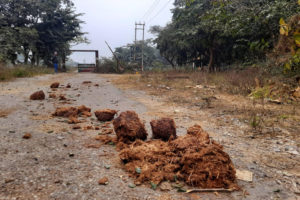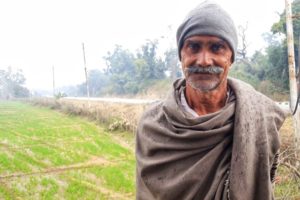By Varsha Singh

In Uttarakhand, every month, cases of wildlife animals like leopards, tigers, and elephants attacking humans are reported. Among these, leopard attacks are the most frequent and severe. The ‘Living with Leopards’ programme, which has found success in Maharashtra, was launched in the Tehri and Pauri forest divisions in 2015-16 and in Narendra Nagar and Pithoragarh forest divisions in 2020 and 2022, respectively. The programme is reportedly successful in Tehri and Pithoragarh but has failed in Pauri, which has been identified as a hotspot for leopard attacks. Mongabay-India correspondent Varsha Singh reports
On January 1 this year, when everyone was welcoming the new year, residents of Panthar village in Chaubattakhal tehsil (district administration) in Pauri, Uttarakhand were seething with anger. A leopard (Panthera pardus) had attacked and injured one of the residents, Pushpa Devi. She was rushed to the All India Institute of Medical Sciences (AIIMS) in Rishikesh, about 250 km away.
Vikas Panthari, the pradhan (head) of Panthar village, told Mongabay-India, “On January 3, angry residents staged demonstrations at the district headquarters after the leopard attack on Pushpa Devi. The number of leopard attacks has increased in our region in the past four-five years. We have been demanding that the forest department should trap the leopards and patrol the area. But every time we are told that there is a shortage of staff.”
On January 9, a street play “guldar bhagao, pahad bachao” (drive away the leopards, save mountains) was staged at Chaubattakhal. Sudhir Sundriyal, a farmer from Mazgaon village in Chaubattakhal, says: “The forest department has failed to contain the leopard problem. If the situation does not improve, the villagers will stage a protest march from Pauri to the state capital Dehradun.”
Recently, a video of a leopard chasing two women in Almora had gone viral on social media.
Eleven-year-long struggle to contain the human-animal conflict
To reduce human-wildlife conflict, the Uttarakhand Forest Department has been working with two non-governmental organizations (NGOs), Titli Trust and Wildlife Conservation Society– India (WCS-India) from the year 2011.
According to the state forest department data, 244 people lost their lives in the state between 2000 and 2010 because of leopard attacks. Between 2011 and 2021, 234 people died. In the year 2022, at least 20 people died.
A report by Titli Trust, published in 2021-22, mentions, “Not a single month passes in Uttarakhand when incidents of attack by leopards, tigers, elephants, or other wildlife animals are not reported. Leopard attacks top the list and are the most severe.”
Between 2011 and 2014, the organisation conducted research on the human-animal conflict in the state, identified hotspots, and mapped the trends of attack. Pauri Garhwal, Almora, Pithoragarh, Rudraprayag, Tehri and Narendra Nagar forest divisions were identified as the hotspots of leopard attacks. Pauri and Almora continue to remain the hotspots.
The ‘Living with Leopards’ programme

Sanjay Sodhi, the founder of the Titli Trust, explains that the ‘Living with Leopards’ programme, initiated by the Maharashtra forest department in the Sanjay Gandhi National Park, was a huge success. Taking a cue from its success in Maharashtra, the same programme was launched in Uttarakhand. In 2015, a team comprising forest department officials, different organisations, and representatives of different mountain communities went to Maharashtra for preliminary research. The ‘Living with Leopards’ programme was named as “guldar ki dagdiya” (stay of leopards) in Uttarakhand.
In 2015-16, the project was launched in the Tehri and Pauri forest divisions, in 2020, in the Narendra Nagar forest division and in 2022, it was launched in the Pithoragarh forest division. Thus, four forest divisions were covered in six years.
Sodhi says, “In the state, in the event of leopard attacks, traditionally, the leopards are killed, relocated, or declared a threat to human life. This has been going on for years. What we learned from the example of Maharashtra was that these methods were actually fuelling the conflict.”
He adds, “Under the ‘Living with Leopards’ programme, primary response teams were formed at the village level, which used to give us information about the appearances of leopards in an area and report instances of leopard attacks. A rapid response team comprising officers and employees of forest departments, veterinary doctors, and forest guards was formed. This team was trained and provided with all the necessary equipment. Along with this, awareness drives were conducted and people were told to carry out certain tasks, including cleaning up the bushes and keeping their homes well-lit. They were also told to walk in groups while venturing into forest areas.”
According to the data collated by the forest department, 37 cases of leopard attacks were reported in Tehri between 2006 and 2009. The same number of cases were reported between 2010 and 2013. While 31 cases were reported between 2014 and 2016, the number of cases came down to nine between 2017 and 2020. Going by the numbers, the project has been a success in Tehri.
In Pauri, 63 cases of leopard attacks were reported between 2006 and 2009. Between 2010 and 2013, the number dipped to 56. But it rose to 102 cases reported between 2014 and 2016, and 30 cases were reported between 2017 and 2020.
Sodhi feels the project was not successful in Pauri. “We don’t know why there have been so many attacks in Pauri and Almora. In these districts, the traditional methods of capturing, relocating, and killing leopards are still being followed in the case of an attack. Also, it is difficult to change the attitude of the forest department officials and the people. We were successful in Pithoragarh. There was not a single death due to leopard attack last year. It’s only been two years since I have started working in Narendra Nagar, so it’s too early to comment,” he said.
According to the data made available to Mongabay by the Uttarakhand Forest Department, from 2001 to 2022, 76 leopards in the state were declared a threat to human life and were killed. In 2022, three leopards — one each in Pauri Garhwal, Tehri and Narendra Nagar divisions — were killed.
When asked why there has been no change in the situation even after so many efforts, Vidya Athreya, a scientist associated with the WCS-India, says sometimes the forest department does not take a lot of interest. The situation is slightly better in areas where people share a good relationship with the forest department officials.
Sameer Sinha, the current chief wildlife warden, says, “We are creating a cell to analyse conflict situations, identify hotspots and collect data to reduce the human-wildlife conflict. This cell will provide us with technical support. The State Wildlife Board has given its nod. The proposal is pending with the Central Wildlife Board.”
Plans are not taking off due to a lack of resources
A Human Wildlife Conflict Mitigation Scheme is being launched in the state to reduce the number of leopard, elephant, and tiger attacks. The ‘Living with Leopards’ programme is a part of this scheme. As part of this programme, activities like solar fencing, setting up of elephant-proof trench, building anti-wildlife walls, water conservation, eradication of wild bushes like lantana and installation of solar lights are undertaken.
While lack of resources and human resources are genuine concerns, the major problem is that the forest department officials are not taking a lot of interest in tackling the existing issues.
For instance, in 2021, during the Kumbh mela (festival), solar fencing was done in areas bordering the Rajaji National Park in the Shyampur range in Haridwar. However, this 18-km long fence was found broken and damaged in most places. An opening was also left open so that people could enter the forest.

Shankar Singh, a farmer from Sajjanpur Pili village, which is adjacent to the Shyampur range, says: “Elephants, leopards, bluebucks, monkeys, and wild boars come to our village frequently. They damage our crops and attack our cattle. The forest department put the fence up but did not maintain it. These barbed wires lasted for four to five months. There is no current in the wire anymore, so wild animals manage to break it. The forest department should have put the fence on the boundaries of our village instead. We would have protected it.”
Shuchi Chauhan, a ranger in the Damdeval forest range in Chaubattakhal, Pauri, says: “We have formed a rapid response team, which only includes the employees. But there are no helmets or other necessary equipment for the safety of the workers. There is a shortage of staff. In the evenings, one forest guard patrols the area. He carries only a stick with him while patrolling. He is also expected to carry out important tasks like containing forest fires and protecting wildlife and forest.”
She further informs that there are nine beats in the Damdeval forest range. Each beat covers a forest area in the range of 500-2,000 hectares. The Chaubattakhal area is spread across 1,000 hectares and there are about 100 villages in that area. However, only one forest guard has been assigned to that beat. She says that no budget has been sanctioned for the past one-and-a-half years for the cleaning of wild shrubs like lantana, which is pertinent in preventing leopard attacks.
How effective were the schemes in Uttarakhand?
According to the data provided by the Uttarakhand Forest Department to Mongabay-India, under the Human Wildlife Conflict Mitigation Scheme, a budget of Rs 23.74 crore was sanctioned from 2018-19 to 2022-23.
In the same period, Rs 35.26 crore has been spent on compensation, Rs 10.37 crore for protection of agriculture from wildlife, and Rs 10 crore for protection from monkeys.
According to the Compensatory Afforestation Fund Management and Planning Authority (CAMPA) report, in 2019-20, Rs 2.5 crore was provided for radio collaring of elephants, solar fencing, patrolling, and awareness drives to deal with the human-wildlife conflict in the state.
Wildlife warden Sinha says that apart from these activities, funds are also provided under CAMPA for water conservation.
When asked to comment on why despite spending crores of rupees and launching programs like ‘Living with Leopards’, the human-wildlife conflict continues to exist, Dharam Singh Meena, Uttarakhand government’s Additional Secretary, Forest and Environment, says: “To prevent the human-wildlife conflict, the work done was mostly superficial. No assessment was done to study the exact impact of these schemes. We do not have any research or data related to this.”
Singh, the farmer, says that human-wildlife conflict is a very serious issue related to the conservation of wildlife. Reduction in the habitat of leopards, obstruction of movement from one forest to another, decline in the population of their prey (wildlife like deer, sambar), expansion of human settlements, increase in human activities around the forest areas and lack of awareness are some of the reasons why there has been an increase in the cases of human-animal conflict.
Sodhi cites the Social Survey Report of 2021-22, which has highlighted the main reasons behind the human-animal conflict. They include lack of food for leopards in forests, construction of roads and houses near forests, increase in human settlements near forests and construction work on the edge of the forest, increase in the area of wild bushes like lantana and the decreasing village population. Sodhi says that we cannot change the behaviour of leopards, but people can change their behaviour.



